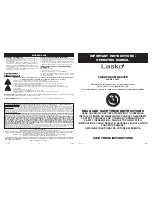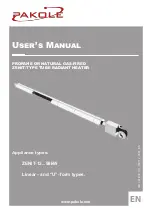
38 www.
hotwater .com
Note:
This rod may reduce but not eliminate water odo r
problems. The water supply system may require special
fi
ltration equipment from a water conditioning company to
successfully eliminate all water odo r problems.
Arti
fi
cially softened water is exceedingly corrosive because
the process substitutes sodium ions for magnesium and
calcium ions. The use of a water softener may decrease
the life of the water heater tank. The anode rod (see Figure
42) should be inspected after a maximum of three years
and annually thereafter until the condition of the anode
rod dictates its replacement (see Figure 43).
EXPOSED
SUPPORT
WIRE
PITTED ANODE ROD
EXPOSED
SUPPORT
WIRE
Figure 43
Note:
Arti
fi
cially softened water requires the anode rod to
be inspected annually. The following are typical (but not
all) signs of a depleted anode rod:
•
The majority of the rods diameter is less than 3/8” .
•
Signi
fi
cant sections of the support wire (approx. 1/3 or
more of the anode rod’s length) are visible.
If the anode rod show signs of either or both it should be
replaced.
Note:
Whether re-installing or replacing the anode rod,
check for any leaks and immediately correct if found.
To Remove The Anode Rod:
1. Turn the gas control/temperature knob to the “OFF”
position (see Figure 31 and Figure 33).
2. Turn “OFF” the gas at the manual gas shut-off valve
(see Figure 1).
3. Shut off the incoming water supply to the water heater
and open a nearby hot water faucet to depressurize
the water tank.
4. Connect a hose to the drain valve and terminate it to
adequate drain or to the exterior of the building. Open
the drain valve and drain approximately 5 gallons of
water from tank. (Refer to “Draining, Re
fi
lling And
Flushing” for proper procedures). Close drain valve
and remove hose.
5. Remove and retain the anode cap on top of the heater
and remove and retain just enough insulation so you
can access to the anode head (see Figure 42). Keep
in a safe place for reinstallation later.
6. Remove the anode rod by using a ratchet and a
1-1/16” socket turning counter-clockwise (see Figure
42).
To Install The Anode Rod:
1. Use Te
fl
on
®
tape or an approved pipe sealant on
threads of the new anode rod.
2. Place the anode rod in the spud (top of the tank) (see
Figure 42) and turn clockwise until the threads are
hand tight. Using a ratchet and 1-1/16” socket tighten
down water tight.
3. Open a nearby hot water faucet to purge air from
the water line. Fill water heater tank completely.
(Refer to “Draining, Re
fi
lling And Flushing” for proper
procedures).
Note:
To assure the water heater tank is full, keep the hot
water faucet open for 3 minutes after a constant
fl
ow of
water is obtained.
4. After turning closing the hot water faucet, check for
water leaks around anode rod and immediately correct
any if found.
5. Reinstall the insulation and anode cap which were
removed in step 5 of removal process.
6. Turn “ON” the manual gas shut-off valve (see Figure
1).
7. Turn the gas control/temperature knob to the “ON”
position (see Figure 31 and Figure 33).
8. Follow the lighting instructions on the label or see
“Lighting Instructions” to restart the water heater.











































